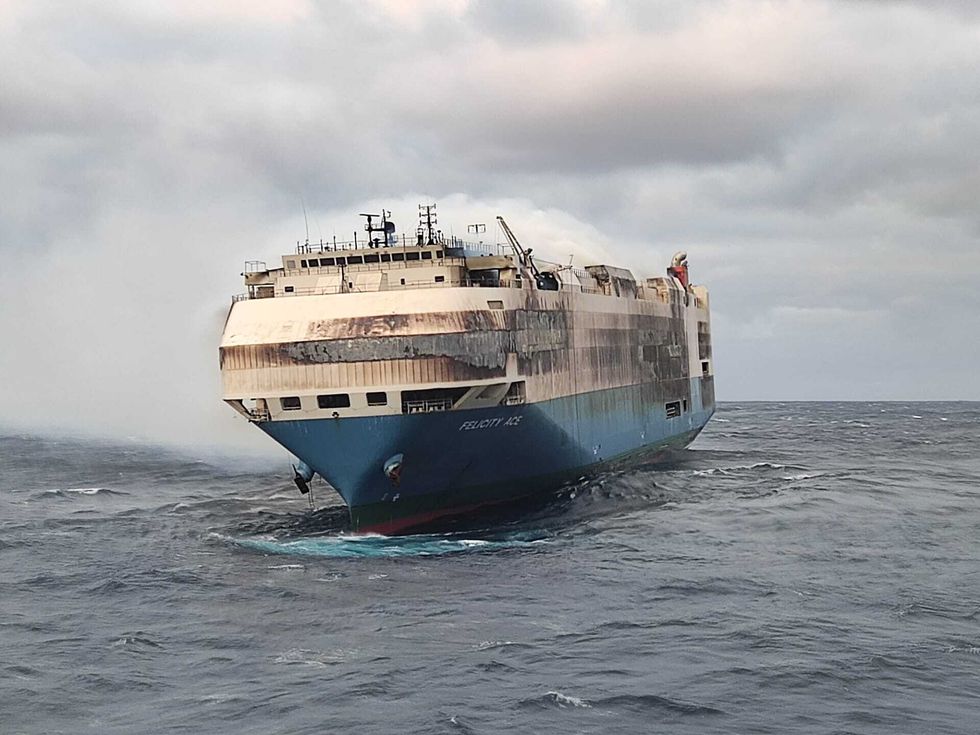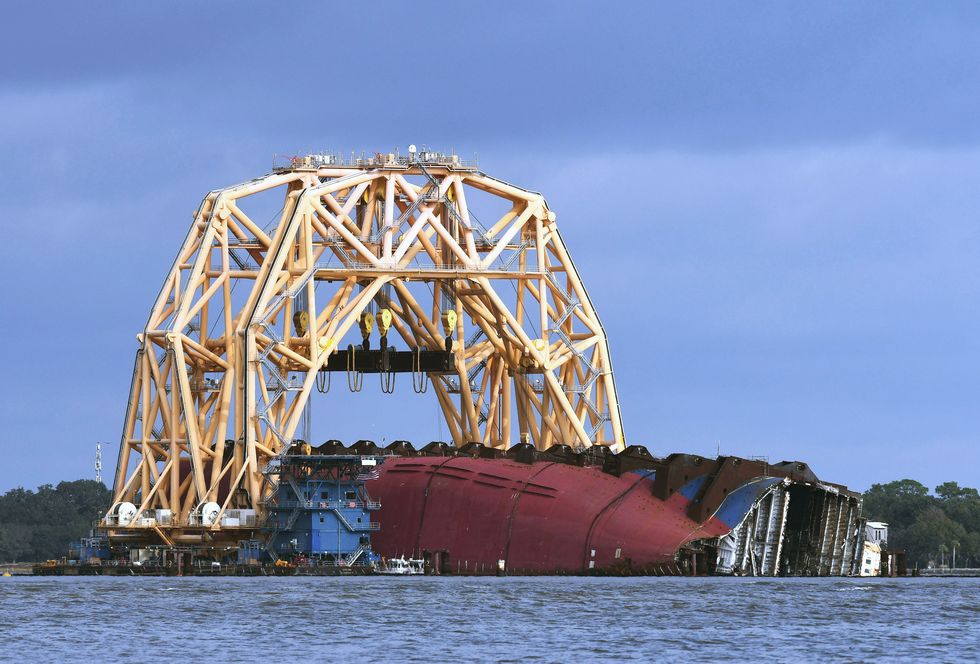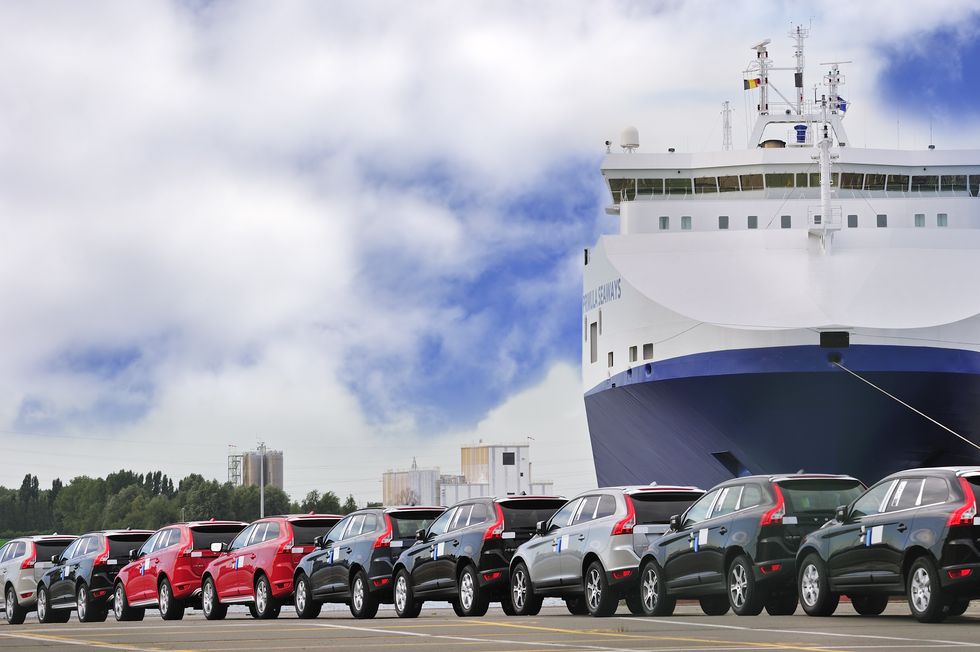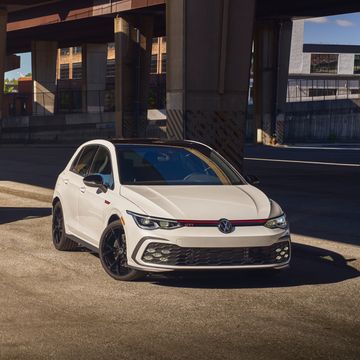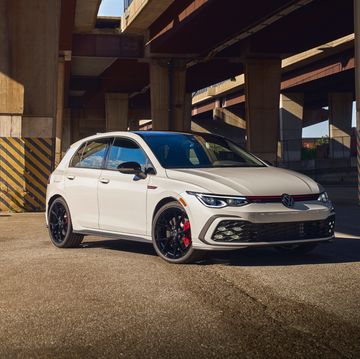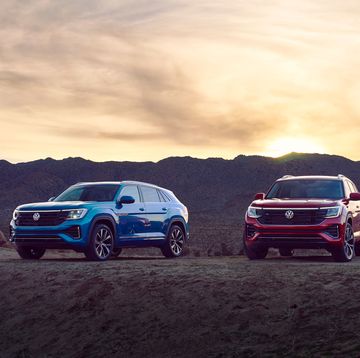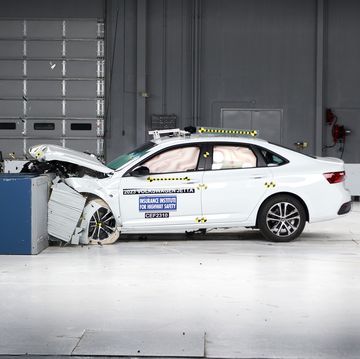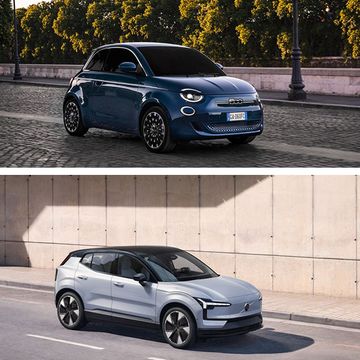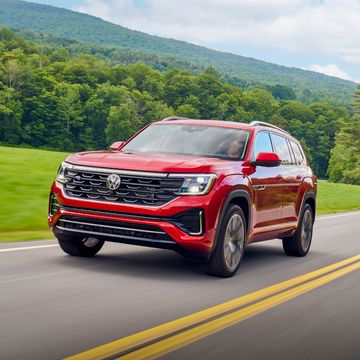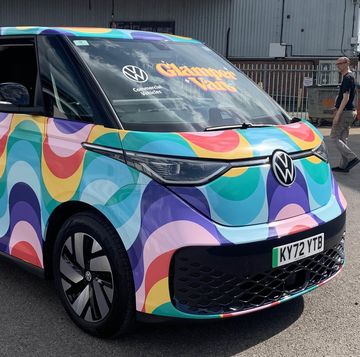- Capt. Rahul Khanna, global head of marine consulting at Allianz, says it's going to be very difficult to find the exact cause of the fire that sank the Felicity Ace.
- The problem with EVs, Khanna says, is that lithium-ion batteries in EVs can actually propagate the fire, igniting more vigorously as compared to conventional cars.
- If EVs are not lashed or adequately lashed and a vessel encounters bad weather, the cars can become loose, have an impact, and cause a fire, the captain says. A single vehicle fire could prove catastrophic.
The recent fire aboard and sinking of the Felicity Ace car carrier brings up a very interesting question: As the world quickly switches to electric cars, how are we going to get them from factories to showrooms, especially when they have to cross oceans?
The cause of the Felicity Ace fire could have just been a cleaning rag that fell onto a hot grill in the galley. It could have been a lit cigarette accidentally dropped in the engine room. Or, and this is the scariest possibility, it could have been caused by a runaway thermal event in an electric car somewhere in the darkest confines of a parking area below deck.
And if it could happen on the Felicity Ace, could it happen on just about any car-carrying ship anywhere?
That’s a lot of ifs. The answers are lying 10,000 feet down in the North Atlantic, 200 miles off the Azores. Interviews with the crew of the Felicity Ace, all of whom were rescued, might provide answers, but that could take a number of years. And retrieval of the vessel, even just sending a deep-sea robot down to look around, might be cost-prohibitive.
A new report by marine insurance specialist Allianz provides some insight. Allianz was not directly involved in the Felicity Ace as an insurer, but the company is heavily involved in maritime insurance. You can read the Allianz report here. Or you could continue here reading our conversation with Capt. Rahul Khanna, global head of marine consulting at Allianz (AGCS). Khanna has 26 years' experience in the shipping and maritime industry, with 14 years on merchant ships in all ranks. Allianz called and offered Khanna’s perspective as it released its report, which includes a section on risks such as those seen with Felicity Ace. Here is our recent conversation with Capt. Khanna.
Autoweek: It seems we may never know the cause of the fire on the Felicity Ace, whether it was a battery in an electric car or something else. Is that correct?
Capt. Rahul Khanna: Unfortunately, that seems to be the case at the moment. I think what we can do in some cases is access the voyage data recorder. It’s like the black box that you have on an aircraft; it’s a similar data recorder that we have on ships as well. Felicity Ace would have had one and hopefully during the salvage operation it was recovered. What that will tell us is not really what happened on the vessel and how the fire started because the voice recorders only cover certain types of data. It also includes the conversations onboard the bridge. And then it has navigation information, it has alarms, and so on. We can probably say okay, the fire started somewhere but if the video has been recovered and analyzed, we can't say what exactly caused the fire. For that we need the physical evidence, which unfortunately is somewhere 3000 meters-plus under the sea.
AW: 3000 meters is not easy to get to. But given the importance of finding the cause for this particular fire compared to other fires, given that cars are all going to be electric soon and so everything shipping with a car has this potential danger, would it be worth locating the wreck and investigating to find out whether it was a car that started the fire?
Khanna: Everything's possible. But it all comes down to the cost/benefit analysis. And yes, you're right that the percentage of electric cars on board car carriers is increasing. And it will continue to rise as we see the shift in the consumption pattern, the shift to climate-change requirements. However, I think the cost in recovering the wreck is a big question mark. The costs are astronomical, because you would have to hire one of these recovery vessels, which will have a remote operated vehicle, ROV, which should have the capability to go all the way down to the wreck. Even if we go down to the seabed and locate the wreck, what are we trying to get from it? If you're trying to ascertain the cause of the fire by now, and five days of burning of the vessel, which probably destroyed all the evidence in the first place, I don't think there is much to be gained by doing that.
The thing that they should have done—or if they haven't done—is to get the voice data recorder so that we can at least get some idea of why or what transpired on that vessel in the time before the fire. And that's probably more important, because if you want to reconstruct the whole incident, trying to find out what really happened exactly, or whether it was electric cars that caught fire or was it something else, I think you have to recover the whole wreck—you probably have to, you know, do some forensic examinations of the evidence that is there. But considering all that evidence is under the sea 3000 meters, whether there's anything useful to recover is a bit of a question mark.
AW: Well, with this wreck, thankfully the entire crew has survived. I assume that the interviews have been conducted and will be conducted with them. Do you think it's possible that such interviews might lead to a cause for the fire?
Khanna: Well that's the hope, certainly it should be. I think in our report, this year, we've also highlighted one other issue, which is the investigation reports that are required to be produced, and detailed investigation should be conducted in any serious casualty by the flag state of the ship. Unfortunately, many times these reports take years to come up. And in some cases, they don't come out at all.
And that is one of the issues that we said needs to change. Now, in this particular case, because the crew fortunately survived, we should get all the statements from the crew. I'm presuming by now they already have all this. But as I said, this report may take a year, maybe even more to come out and even then what are we going to find out maybe short of finding out the exact reason the fire started? Because at the moment, imagine that scenario on board the vessel. The crew would have notified or would have been notified by a fire alarm, whether they were able to get down to the base of the fire, where exactly it was, whether they saw a single car on fire or by the time they saw it, it was already too late. All these questions are going to be answered only in the investigation.
AW: So it’s likely that we won't ever determine a cause for this fire.
Khanna: Unfortunately, that is probably the case—it's going to be very difficult to find the exact cause. What we do know is there have been many cases of EVs catching fire on board these vessels, many of them fortunately didn't reach the same conclusion as Felicity. There have been quite a few, let's say, near misses that the industry has seen over the years. And we—when I say we, it's an industry—we recognize the fact that EVs can be problematic, especially when it comes to fire.
AW: I wasn't aware that there were so many others. Approximately how many other incidents have there been that you're aware of?
Khanna: I don't have all the details here on exactly how many EVs caught fire or have these fires (occurred) on both ro-ro vessels (roll-on/roll-off car-carrying ships where the vehicles are driven on and off the ship and parked on one of several open decks), but there have been quite a few instances in the past. Top of my head, I don't know the number. But we analyze the number of fires onboard ships, and one of the key categories of the ships that had fires were containers and ro-ro vessels. So there were about 70 fires reported in the last five years, which is quite a large number. That's actually on the container, which was not in the ro-ro vessels. I don't have the number of ro-ro vessels unfortunately.
AW: But it's fairly common, then?
Khanna: Yes, the fires do happen. And the other thing is, so many of them would not make the statistics because they might have been controlled by the crew themselves within the first few minutes. As we know, to control a fire, the first three to five minutes are the most important. If you can react quickly and act decisively, the fires can be put out. Being in the industry, we know that there have been quite a few.
AW: Do you know if those were electric cars? Are electric cars catching fire on these ships? Or was this Felicity Ace fire really the first time that an electric car might have been involved?
Khanna: We don't have the details of these incidents—we do just the overall statistics. So it's really hard to say, in a particular vessel, this particular car has caught fire. The key issue here is that fire is one of the biggest hazards on board ships. And what we know is that carrying electric vehicles on board, the ships encounter a relatively new type of risk. It used to be internal-combustion engines. The ships were designed over the years and firefighting measures and fire protection measures were designed to work on the basis that cars and vehicles have internal-combustion engines.
Now that risk is substantially changed, and the structure of the risk is changing. And now we've got more electric fires ... now we have a completely different source. The way these (ro-ro) ships are designed, because they need to carry cars, there are wide-open spaces on these ships. And if a fire does start, it has a lot of space and opportunity to spread around very quickly. Compare this to some of the other types of ships where you have fire partitions within the ship. And if fire starts in one compartment, it may stay in that compartment. But in ro-ro vessels because they are wide-open spaces from front to back, that kind of segregation is not possible. So the fire retardant, from a design perspective, is not there.
The second issue is ... firefighting involves a large amount of water to be put into these open holes. That creates stability issues for the ships and that's the other problem that specifically ro-ro vessels have. (There was some discussion about the stability of car carriers and how proper loading and ballasting increases stability.)
AW: Would you say that ro-ro vessels are inherently more dangerous than typical cargo vessels, which I guess would be container ships?
Khanna: You have container ships and you have general cargo vessels as well. So there's different categories, but it might be a little unfair to say that they are inherently more dangerous. What you can say is that they require specific risk-mitigating actions, when it comes to stability and fire with these vessels. They require some enhanced mitigation procedures and methods to be taken by the crew, by the loaders, shippers who are loading these vessels and as long as they can take care of these vessels they should be safe. And they have been. However, the margins of error are a little less than when it comes to other vessels.
AW: Is there a way to make shipping electric cars safer?
Khanna: There have been fires on ro-ro carriers earlier (before the rise of EVs) as well because of the fuel inside the car leaked or something else happened. The problem with EVs is that the lithium-ion batteries can actually propagate the fire. In fact, they can actually encourage a fire if a fire has already started and you have lithium-ion batteries—they can ignite a lot more vigorously as compared to any other cars.
The other issue is the starting of the fire. a typical ro-ro vessel would move on the seaways and so, you have the cargo which is moving, the vessel rolls and pitches—the normal motion of any ship. In the case of ro-ros it may be a little more pronounced. But that is counteracted by making sure the sea fastenings and the securing of these cars gets done properly. With that is where the problem lies. If it is not secured properly, then these cars can move. A high impact on these cars and a lithium-ion battery can ignite them. We know this from some of the research. There's a complicated problem.
The way to address this is twofold. First, ensure that all the securing is done efficiently and is correctly monitored and checked and rechecked before the vessel sails. And the same thing applies to the stability checks. You may remember the Golden Ray incident (a car carrier that capsized in US waters, resulting in one of the most expensive recoveries in history). It had a similar problem like lost stability while turning. Clearly the problem was that stability wasn't adequately checked and the ballast changes that they were supposed to have done were not done correctly or not done at the right time to ensure that the cargo, i.e. the cars, are secured properly.
Stability checks are not done correctly before the vessel sails many times because of commercial pressure, because the ships run between ports very quickly, and they're running on very tight schedules. Some of these actions which should be done prior to sailing are left to be done too late. Some people might call us and say, ‘We'll carry out the action once the vessel's sailing.’
The second thing is fire protection and production. The fire protection measures that are on board the vessels are typically designed for fires with ICE engines in mind. Now they need to be redesigned to ensure that if there is a fire—and then we are talking about batteries, whether it's lithium-ion batteries or any other type of batteries—the fire extinguishing methods need to be tailored to different types of risk that we're talking about. These are the two ways we can at least reduce the risk on a ro-ro ship, or the cars simply parked on a deck or are they parked and tied down. Each and every car is supposed to be lashed in a specific way, taking into consideration how much force the vessel will experience, or is expected to experience during its passage. So they are tied down with clamps or chains at times, depending on the type of car, the type of vehicle.
AW: If an EV was not tied down, then the collisions on the decks between that cars could result in a fire.
Khanna: Exactly. So that's one of the key issues. If they do not have enough time to secure all the cars before sailing, the vessel comes out and suddenly encounters bad weather, the cars which were not lashed or not adequately lashed, may become loose and have an impact that can cause a fire. And that is the cause of fire in many cases.
AW: Can you tell me the percentage of car carrier vessels among the world's cargo ships?
Khanna: I don't have the exact number because the category—you can have ro-ro, you can have ro-ro passengers, you can have multimodal vessels as well. Six thousand to 8000 such vessels of all sizes and shapes. I would say definitely less than 10% of the global fleet.
AW: So they're not the most common out there. But with the rise in electric cars, they certainly have the potential to be something that we should focus on. And maybe it sounds like we have to adapt new methods for safety, especially in regard to fires on these ships transporting electric cars?
Khanna: Absolutely, I think this is the point we've highlighted in the report as well. We've said that fire on ro-ro vessels needs to be addressed. And of course, not just the fire, but the stability aspects as well need to be addressed. Another point that comes up is the cost to the industry when something like this does happen. I think we've also seen a reversal. The salvage operation of the car carrier Golden Ray has costed roughly $800 million so far—it might increase even further. And that's a massive number compared to the cost of the vessel and the cars itself. $800 million is an astonishing amount of money to be spent on all of these vessels.


